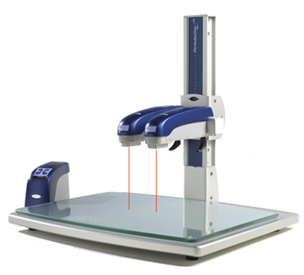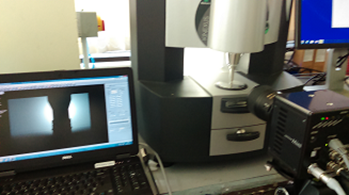Characterisation of Functional Inks
 Project Overview
Project Overview
The Characterisation of functional inks project was funded by the Welsh Government through the Academic Expertise for Business (A4B) programme. The 12 month project applied advanced rheological characterisation techniques to functional printing inks. With increased understanding of the behaviour and characteristics of these complex multiphase fluids better control and predictable performance can be achieved.
Working in collaboration with industrial partners the project investigated drying characteristics of the curing inks through bulk and surface rheology and ASII profiles. Transfer phenomena during ink substrate interaction and multifilament formation during extensional separation of printing plates were investigated. Another area of investigation was the combination of shear and extensional viscosity in combination.
 Current state of the art is to investigate shear rheology such as viscoelastic, thixotropy and shear thinning behaviour. There is also the ability to investigate extensional viscosity where the fluid is contained between two parallel plates, the plates are then pulled apart and the filament formation and break up monitored. There has to date been no combination of the two which is an important concept for consideration of printing inks. During the printing process inks are first sheared and then the final transfer is an extensional separation. The amount of shear and speeds of separation are different for different processes but it is present in all major printing processes.
Current state of the art is to investigate shear rheology such as viscoelastic, thixotropy and shear thinning behaviour. There is also the ability to investigate extensional viscosity where the fluid is contained between two parallel plates, the plates are then pulled apart and the filament formation and break up monitored. There has to date been no combination of the two which is an important concept for consideration of printing inks. During the printing process inks are first sheared and then the final transfer is an extensional separation. The amount of shear and speeds of separation are different for different processes but it is present in all major printing processes.
New equipment was bought for this project that enabled the team to advance the characterisation of functional printing inks.
The Formulaction Horus ASII is used for analysis of ink drying, the single wavelength laser is shone onto the ink surface to create a speckle pattern. As particles and solvent in the ink move the speckle pattern changes, the change is monitored and the rate of change recorded as fluidity factor. As the ink dries the movement decreases and fluidity factor decreases with distinctive changes at various points from wet to touch dry to full dry.
 A Photron Mini UX100 high speed camera was used with the existing extensional rheometer which was also adapted for investigation of ink-substrate interaction and multifilament formation. Another major use of the high speed camera is the investigation of combined shear and extensional rheometry. In order to conduct this measurement an advanced rheometer is needed and therefore the team used the Malvern Kinexus Pro.
A Photron Mini UX100 high speed camera was used with the existing extensional rheometer which was also adapted for investigation of ink-substrate interaction and multifilament formation. Another major use of the high speed camera is the investigation of combined shear and extensional rheometry. In order to conduct this measurement an advanced rheometer is needed and therefore the team used the Malvern Kinexus Pro.
The rheometer has the ability to conduct highly accurate shear rheology and also has strong vertical capability with control of speed and force of separation. Combining Kinexus Pro with the Mini UX100 gives us the ability to shear the ink and immediately conduct extensional analysis replicating the treatment of the ink during the printing processes.
Services Available through this Project
Film Formation and Drying Analysis
Using the Formulaction Horus ASII system we can characterise the stages of film formation and drying on inks covering all printing processes. We can use any of the range of printing equipment available at WCPC to create samples for analysis, however a simple drawdown test under the ASII measurement head is often the most appropriate sample preparation method.
Using techniques developed under the A4B Characterisation of Functional Inks, project samples created are measured using a monochrome laser system to analyse particle movement within the sample.
As the ink dries and film formation occurs characteristic profiles in the ink fluidity factor reveal important characteristics such as time to touch dry and time to full dry or conversely open time. As an example the system can be used to increase productivity, as samples can be temperature controlled the time to full dry at process drying temperature can be measured giving confidence to increase production speed or potential to reduce drying temperature reducing energy consumption.
There are many further applications that can be applied to ink formulation and print production, for more information please contact Dr David Beynon
Advanced Rheological Measurement
WCPC is able to offer a range of rheological testing solutions and have added to this with support from the A4B Characterisation of Functional Inks project.
We offer high accuracy shear rheology testing using standard and advanced characterisation techniques such as shear viscosity profiles and oscillation testing and have added to this with the new Malvern Kinexus Pro Rheometer. This rheometer when combined with high speed camera imagery and analysis allows us to apply shear to the ink with extensional rheology of the ink in the sheared state.
Conducting measurement in this way closely matches the treatment of inks in the printing process where for the majority of processes the ink is sheared by rollers or squeegee before the final transfer to substrate. When transferred to the substrate the ink makes contact with the substrate and then undergoes an extensional flow as the substrate and plate or screen separate. The filament formation, flow within the filament and filament break up are crucial for the definition of the printed feature.
The measurement procedure can be applied to a wide range of inks and is particularly useful for the development of functional inks where precise, repeatable deposition is critical for device performance.
For more information on how this unique technique can help you contact Dr David Beynon
Project Details
Duration: Ongoing
Project Lead: Dr David Beynon
Download this page as a PDF


